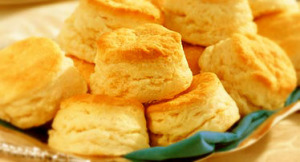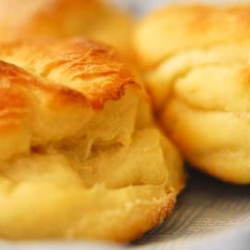
In the South, we take a lot of things in stride. If it rains on game day, we shrug and celebrate that at least we don’t have to work in the yard. If our car breaks down, we call someone to pick us up. But whatever you do, don’t mess with our biscuits.
The biscuit is a Southern staple. For breakfast, you can fill it with eggs, sausage, bacon, country ham, cheese, breaded chicken, pork loin, steak. You can drown it with sausage gravy, milk gravy, red-eye gravy. Or you can simply slather it with butter and eat it straight.
As the South has been infiltrated by different cultures, the biscuit has taken on other unlikely partners. Chicken-fried steak. Kielbasa. Bratwurst. I’ve even seen them served with salami and pastrami, accompanied with spicy mustard.
But no matter how many different items the biscuit gets paired with, the Southern biscuit itself remains constant. When baked to perfection, it sports a golden crown that glistens with freshly drawn butter. Its texture remains flaky throughout while still retaining the consistency between a heavy bread and croissant. And when it enters your mouth, it melts over your tongue like cotton candy with a unique flavor that can’t be duplicated.
The traditional Southern biscuit usually contains just a few simple ingredients: all-purpose flour, leavener, fat, milk, salt. It’s a member of the quick break family, which means that it uses chemical leaveners (baking powder and/or baking soda) rather than yeast to achieve it’s rise during baking. The fat is usually a proprietary combination of one or more of butter, margarine, shortening and lard. The milk is usually whole milk or buttermilk, but reduced fat milk can also work.
But even with its simple ingredients, making the Southern biscuit is not an easy feat to master. One must take special care to mix the ingredients thoroughly while not overmixing them. The fat used must always be cold, if it is cut into the flour mixture at room temperature, the biscuits will come out wrong. If overmixed, the biscuits will simply fall apart without any cohesiveness.

Mixing the biscuits the proper time allows the glutens in the flour-milk combination to form and remain connected. Using cold fat allows tiny globules to remain whole in the biscuits as they bake. The result is that the fat melts betweens the glutens and provides the flakiness Southerners have come to expect and love. The French use this same trick with their pastries. Using the correct (and fresh) leaveners allows the biscuit to rise to a certain fluffiness. And spacing on the pan even matters; the farther apart they are, the crispier they are on the top and bottom.
The combination of texture, fluffiness and flakiness is particularly unique to the Southern biscuit. There is no other creation like it anywhere. When baked just right and served hot off the pan after being brushed with melted butter, a biscuit can truly be a slice of heaven.
Buttermilk Biscuit Recipe:
2 1/4 cups Flour 2 1/2 ts Baking powder 1/2 ts Baking soda 1/2 ts Salt 1/2 cups Shortening (cold) 1 1/4 cups Buttermilk 4 tbs Butter (melted)
Flatten shortening out on wax paper or plastic wrap and place in freezer while you sift all the dry ingredients (flour, baking powder, baking soda and salt) together several times from bowl to bowl.
Remove shortening from freezer. Break into small bits and drop into bowl of dry ingredients. Using fingertips, lightly rub shortening and flour together, occasionally tossing flour mixture so you touch all particles of shortening with flour.
Using fork, add buttermilk, lightly stirring to mix with dry ingredients until it reaches the consistency of small garden peas. Cover board or surface with dusting of flour. Gather sticky mass of dough and place on floured surface. Dust hands with flour and gently knead dough, adding enough flour only to make dough manageable. Pat dough with hands or roll with floured rolling pin into round 1/2-inch thick.
Using 2-inch cutter, cut out biscuits and place touching each other in 3 rows, in center of greased and lightly floured baking sheet. Reform scrap dough, working it as little as possible and continue cutting biscuits. (Believe it or not, biscuits from the second pass will not be quite as light as those from the first.)
Place on middle rack of 425-degree pre-heated oven and bake 12-15 minutes (or 450 at 10-12 minutes), or until lightly golden. Remove from oven, brush with melted butter and serve hot or warm. Makes 19 (2-inch round) biscuits.
Tips:
– Always add ingredients in order specified. That order exists for a scientific reason.
– Use fresh baking powder and baking soda or they will not rise properly. This makes a much more tender biscuit.
– Do sift the dry ingredients many times, this prevents clumping and allows the flour to touch the fat at all times.
– When cutting biscuits, never twist the cutter; that will seal the edges and prevent proper rising.
– Place biscuits on the pan not touching for crispness, or together for tenderness.
– Do not overwork the flour mixture, stop when you reach the consistency of small garden peas.
– Do not roll and work dough ball or fold over on itself. This will destroy the glutens formed and cause the biscuits to come apart.
– If you don’t have buttermilk. Add a teaspoon of lemon juice per cup of regular milk and let sit 15 minutes. Do this before you begin to make the biscuits.

